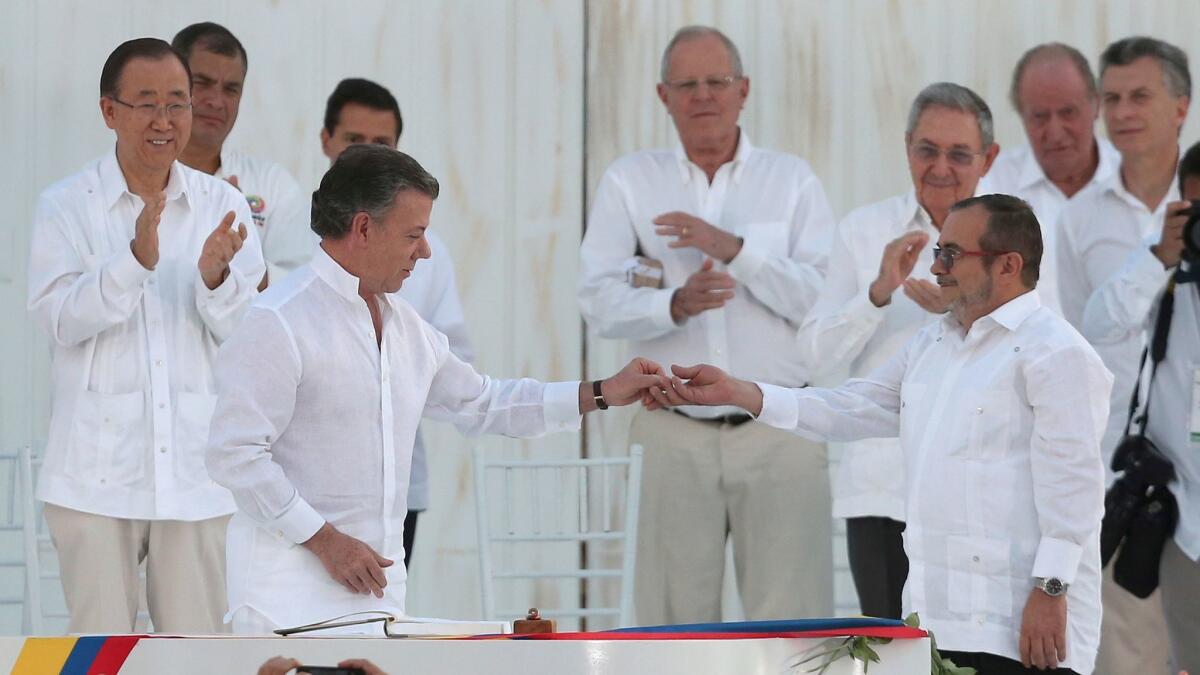Colombia government, rebels sign revised peace agreement

- Share via
Reporting from BOGOTA, Colombia — Colombian President Juan Manuel Santos signed a new peace agreement with the country’s largest rebel movement on Thursday, aiming to end a half century of hostilities.
Santos and Rodrigo Londono, leader of the Revolutionary Armed Forces of Colombia, signed the 310-page accord at Bogota’s historic Colon Theater — nearly two months after the original deal was rejected in a referendum.
After signing, they clasped hands to shouts of “Yes we could!”
Thursday’s hastily organized ceremony was a far more modest and somber event than the one in September where the two men signed an accord in front of an audience of foreign leaders and United Nations Secretary-General Ban Ki-moon.
The new accord introduces some 50 changes intended to assuage critics led by powerful former President Alvaro Uribe. They range from a prohibition on foreign magistrates judging crimes by the FARC or government to a commitment from the insurgents to forfeit assets, some of them amassed through drug trafficking, to help compensate their victims.
But the FARC wouldn’t go along with the opposition’s strongest demands — jail sentences for rebel leaders who committed atrocities and stricter limits on their future participation in politics.
In an act of protest, members of Uribe’s political party are considering a boycott of next week’s scheduled debate in Congress on ratifying the agreement, accusing the legislature of disobeying the constitution. They’re also threatening to call for street protests to denounce what they say is a “blow against democracy.”
“The government preferred to impose itself in a way that divides Colombians instead of a national pact that would bring us together,” Uribe’s Democratic Center party said in a statement Wednesday.
The lack of broad support for the accord will make the already-steep challenge of implementing it even tougher.
Colombians overwhelmingly loathe the FARC for crimes such as kidnappings and drug-trafficking. Ensuring that the 8,000-plus fighters don’t wind up joining criminal gangs rampant throughout the country, or the much-smaller National Liberation Army, will also test the state’s ability to make its presence felt in traditionally neglected rural areas at a time of financial stress triggered by low oil prices.
There’s also a risk that peace could trigger more bloodshed, as it did following a previous peace process with the FARC in the 1980s when thousands of former guerrillas, labor activists and communist militants were gunned down by right-wing militias, sometimes in collaboration with state agents.
That fear, although less prevalent than in the darker days of Colombia’s half-century conflict, has become more urgent with more than a dozen human rights defenders and land activists in areas dominated by the FARC being killed by unknown assailants since the first signing ceremony in September.
Santos this week held an emergency meeting with his Cabinet and U.N. officials to discuss the killings, taking an opportunity to reinforce his message that peace can’t wait. This year, 70 have been killed, according to Bogota-based We Are Defenders, more than in all of 2015 and 2014.
“We have to take action. There’s no time to lose,” Santos said in a televised address announcing Thursday’s ceremony with less than 40 hours of anticipation.
Once signed, Santos will introduce the accord to Congress, where a solid majority in support of peace is expected to ratify it as early as next week. Lawmakers will then embark on the nettlesome task of passing legislation so the guerrillas can begin concentrating in some 20-plus demobilization areas where they will begin turning over their weapons to United Nations-sponsored monitors.
MORE WORLD NEWS
Inside the Indian IRS scam that cheated U.S. taxpayers out of millions
South Korea’s political scandal leaves the country with abysmal options
Britain’s sweeping surveillance powers act raises concerns for human rights activists
More to Read
Sign up for Essential California
The most important California stories and recommendations in your inbox every morning.
You may occasionally receive promotional content from the Los Angeles Times.










